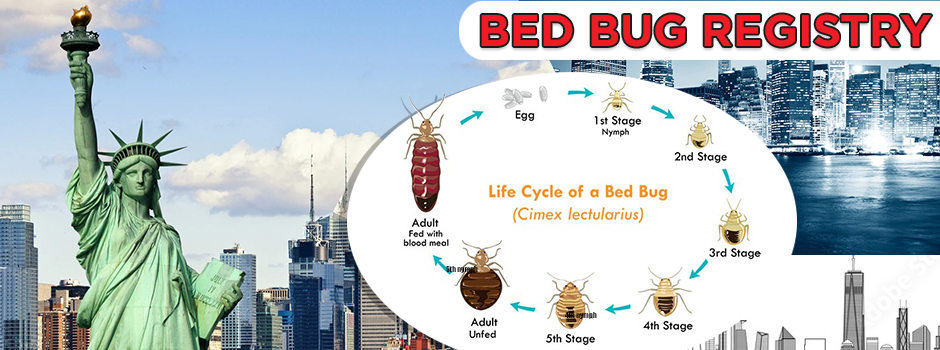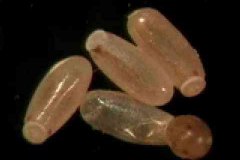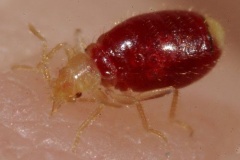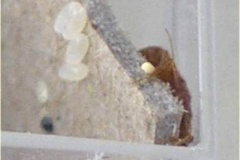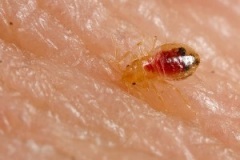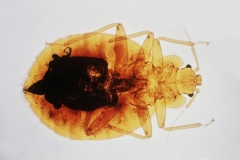1. Affordability2. Communicating that they have an issue due to cost.3. Do it yourself treatments Safety Inneffectiveness4. While trying to do it themselves they spread to other units5. Discarding of furniture (Not wrapping and spreading)6. Other Tenants picking up said discarded furniture
1. Education We provide Classes for Tenants and Staff to familiarize them with what they look like and how they are transferred.
2. Inspect Furniture before new move-ins.
3. Have unit inspected by a professional right after a tenant moves out. Get inspection report with findings. If not there can be a battle if there are bed bugs found within the first few months of a new tenant. The tenant will claim they were there when they moved in. Landlord cant prove they werent.
4. Let the tenants know that if they report a bed bug situation the landlord will handle it and make the tenant pay affordable payments until it is paid.
5. Repeat (numerous) offenders at some point will be evicted if not reported.
Tenants need to realize that Bed Bug Treatments are expensive and Landlords dont want them in their properties. Landlords need to realize that in many cases the tenant really didnt do anything wrong. Through education the tenants can be taught what not to do when it comes to bed bugs.
Excerpts from
Think Like A Bed Bug by: Denise Donovan (IBBRA.org)
When I was deciding on the title, as part of my entomological research, I knew that in order to combat any insect you need to know their traits and behavior in order to outsmart them and thus Think like a Bed Bug became the name of my book.
Thanks Mike for addressing this so well.
Infestations left untreated or not treated correctly because of not understanding the insect seem to be one of the biggest causes of the continued spread within multi-unit properties. Managing bed bugs takes more than a chemical or heat treatment; it takes knowing thy enemy.
Think Like a Bed Bug
Bed Bug Supplement
Know thyself, know thy enemy. A thousand battles, a thousand victories. Sun Tzu, the Art of War
January 4, 2016 Sydney E. Crawley, Michael F. Potter and Kenneth F. Haynes
Around 512 B.C., Sun Tzu and the brightest military minds agreed: to defeat the enemy, you must know the enemy. Fast-forward to today and researchers and pest managers alike are coming to the realization that there are no silver bullets in todays war against bed bugs. Nonetheless, scientists around the world continue to study bed bug biology and behavior in hopes of finding chinks in their seemingly impenetrable armor. The intent of this article is to give practitioners a better feel for what everyday life is like if youre a bed bug, and how some of these insights may lead to improvements in management.
BIOLOGY BEGETS BEHAVIOR.To decipher bed bug behavior one must first know the traits that allow them to survive and produce offspring. The most critical adaptation for survival is their ability to feed exclusively on blood. After hatching, bed bugs molt, shedding their exoskeleton five times before reaching adulthood. Each of these five progressions requires that the insect take another blood meal. Bed bug nymphs seemingly behave similarly to adults, although more research should focus on juvenile bed bug behavior. We do know that young nymphs are more prone to desiccation and may have dispersal habits that differ from adult bugs.
Once a bed bug is an adult, they will need to continue to take blood meals in order to lay eggs and produce offspring. Feeding occurs during times when the host (usually us) is least likely to be aware of their presence. Thus, they forage for blood when we are fast asleep, and their bites are not easily detectable. The period during and directly after feeding is often when mating occurs. Mating behavior among bed bugs is traumatic for females, with males piercing their abdominal cavity directly. Each bout of feeding puts a female at risk for roughly five traumatic inseminations, not necessarily from the same male suitor. These excessive mating attempts can reduce female lifespan. Mated female bed bugs lay approximately 120 eggs (on average) in their lifetime, enabling infestations to grow rather quickly. These biological principles give rise to predictable behaviors displayed in the field, some with implications for management.
Bed bugs characteristically form dense, hidden aggregations in small spaces.
LOVE THE ONES YOURE WITH.If youre a bed bug, there arent many opportunities for privacy. From the moment a pinhead sized neonate emerges from an egg, other bugs both younger and older arent far away. In fact, scores of individuals may be sharing a crevice no wider or deeper than a toothpick.
The tendency for bed bugs to form tightly packed, dense, hidden aggregations is one of the most striking behaviors they exhibit. Within these aggregations, a bed bug will grow, defecate, and mate with other bed bugs that are typically from the same maternal lineage. This aggregation behavior represents a significant advantage to a parasite that feeds on a host that routinely sleeps in the same place. Many of the close relatives of bed bugs, including bat and bird bugs, share the same adaptation.
When deciphering bed bug behavior, it helps to think in terms of what may be in it for the bug. For instance, the tendency of bed bugs to form aggregations would not exist if there were not some intrinsic benefit. Recent studies have revealed that bed bug nymphs reared in groups develop faster than nymphs reared in isolation (Saenz et al. 2014). It also has been shown that bed bugs in an aggregation avoid dehydration much more effectively than bed bugs held alone (Benoit et al. 2007). This probably helps account for the remarkable length of time that bed bugs can survive without taking in any blood for months, or even more than a year in cooler environments. Seemingly, bed bugs that stick together may fare better when the going gets tough and hosts are scarce. Other benefits that have been proposed but not verified include the ability to discourage predators (although predation on bed bugs in our homes is relatively rare), the transfer of beneficial microorganisms between group members, increased opportunities for mating, or caring for offspring. These behaviors exist in other insects that aggregate, but have not been confirmed for bed bugs.
Bed bugs detect chemical cues in the environment with their antennae.
Although aggregating has clear benefits, it is possible to have too much of a good thing. There are also potential risks associated with large aggregations. For instance, the larger the aggregation gets, the more likely you are to become conspicuous to humans trying to kill you. Additionally, competition for mates might become fiercer within these large groups. Perhaps your risk of infection from fungi or other pathogens rises as feces and other debris accumulate in increasingly crowded areas? These potential risks may explain why some researchers have observed a cap to aggregation sizes, which may help us to one day predict why and when bugs within an aggregation may leave their current setup for something better (more on this later).
CONVERSATIONS WE CANT HEAR.Much progress has been made in our understanding of why bed bugs aggregate. For a bed bug to detect the presence of another bug and begin the formation of a group there is communication between them. Insects often send messages to one another to initiate a social interaction. An effective message will be received and interpreted by another bug and a behavioral response, such as aggregating, will follow.
Although not apparent to us, bed bugs are talking in this manner all the time. These conversations are chemical in nature, and since the chemical message benefits the signaler and the receiver we call them pheromones. Pheromones are the main way insects communicate, and those that cause bed bugs to aggregate are appropriately termed aggregation pheromones. Bed bugs detect these compounds with receptors located on their antennae, which serve as the olfactory organ for most insects. Although the social nature of bed bugs cannot be compared to the caste systems of termites or ants, it should be clear that bed bugs do in fact have numerous important social interactions within aggregations.
Bed bugs have few natural enemies, but sometimes are eaten by spiders and ants.
Aggregation pheromones are deposited by bed bugs when they find a suitable place to call home the seam of a mattress or recliner, crevices of a nightstand, etc. We know that there are two parts to a successful aggregation message to other bugs.
One part of the message is released into the air with some of these compounds coming from the scent glands. The other part is deposited directly onto the surface through feces or shed skins and persists in the environment for longer periods of time. All bed bugs respond to the aggregation pheromone.
On substrates, five volatile compounds within the feces or on shed skins attract bed bugs to safe places, while a longer-lasting component (histamine) causes bed bugs to stop and remain there (Gries et al. 2015). The arresting power of the compounds is so powerful that they cause bed bugs to rest on surfaces treated with certain insecticides, which otherwise they may find repellent (Romero et al. 2009). Once the bed bugs have found a suitable place to hunker down, the behavior is reinforced through touch; similar to cockroaches, bed bugs respond positively to contact from other bugs and from the walls of small spaces.
Bed bug feces contain a pheromone that causes bed bugs to aggregate.
LEAVE THE ONES YOURE WITH.Although bed bugs are considered sedentary creatures, there are many times when they leave the security of their aggregation. Bed bugs move when theres a perceived threat, when they need to feed, or when their current location is no longer hospitable such as when a host is no longer available.
Bed bugs tend to respond negatively to light so they may move away from light toward darkness. There is also some evidence to suggest that in addition to light and dark detection, bed bugs may use vision to differentiate between darker and lighter harborages, with a preference for darker colors. Understanding the mechanisms and triggers of bed bug movement will help in preventing their spread from one location to another.
To better understand bed bug dispersal we need to ask ourselves, Why would it benefit a bed bug to leave home? A bed bug on the move risks death when detected by the host. Even without insecticides, humans are a lethal threat and perhaps their greatest risk of a quick demise. Wouldnt it be wiser to remain inconspicuous? Unfortunately, for us, bed bugs have finely tuned adaptations that allow them to avoid periods of time where their movements would be riskiest.
Bed bugs require blood to grow and reproduce, so adaptations for finding a host and taking a blood meal are critical for their survival. Feeding strategies have been fine-tuned over the eons that bed bugs and their buggy ancestors have been parasitizing humans, so theyve become experts at the process. Every time a bed bug feeds they risk detection and death, so quick movement to and from the host is of paramount importance. Like many other animals, bed bugs follow a circadian rhythm, exhibiting predictable behaviors that occur cyclically over 24-hour periods. For bed bugs, these changes are set by the change from light to dark and in fact, bed bugs move more in the dark than in light even in the absence of host cues.
This cyclical pattern includes seemingly random movements that are not directed towards or away from the host, but are, nonetheless, the first step to finding their next meal.
Once theyre triggered by nightfall to move away from aggregations, research indicates that carbon dioxide emission is one of the first cues that stimulate bed bug movement from a distance. As the bug gets closer to a warm-blooded host, their movement becomes more directed as heat is detected. Bed bugs have specialized sensory structures on their antennae that can detect even small fluctuations in temperature. However, bed bugs are not akin to heat-seeking missiles it takes time and many blundering movements based on heat gradients and elevated levels of carbon dioxide to make their way to the host. The exact distances over which bed bugs use heat and carbon dioxide to fine tune their movements are still in question. Determining whether these directed movements start at a few feet or a few inches from the host requires following the movements of individual bed bugs before feeding.
Bed bugs spotted by humans often suffer a quick demise.
The research regarding attraction to human odors is also controversial. Early research suggested that skin odors could have a subtle effect on host attraction, but not nearly as pronounced as the effect of heat. These results should be taken with some caution, as other studies have actually shown that human perspiration is repellent. More work will be necessary to tease apart the role of human odors on bed bug host-seeking. It seems safe to conclude, however, that heat, carbon dioxide and darkness are definitely triggers for most bed bug movement. It could be that some host cues provide directional information (such as heat, which our lab observed directional orientation within 12 inches; Haynes et al. 2008), while others such as carbon dioxide function more as activators, intensifying random movements that are innately turned on each night. (See figure above.)
DO NOT DISTURB.Not all bed bug movements are meant to help them find food; they also may move or disperse in response to threats. Bed bugs emit alarm pheromones when they are disturbed. Interestingly, the bed bug alarm pheromone contains two of the same compounds as the aggregation pheromone, but they are released in much higher quantities when the bed bugs are alarmed. At these levels, these compounds stimulate immediate, rapid movement away from the current location. Unfamiliar touches, light or high, steady levels of carbon dioxide/wind trigger the release of these compounds and subsequent movement. Alarm pheromones, like most chemical compounds for bed bugs, also are detected with the antennae. Humans actually can smell the volatile release of alarm pheromones, that oft-described obnoxious sweetness or buggy odor that is sometimes evident with heavy infestations. The alarm odor is perhaps most apparent when several bugs are confined in a small container and gently shaken.
Tracks of individual bed bugs in a laboratory test arena. Bed bugs cover a lot of ground at night even when not stimulated by a host (top). Note how they tend to follow the edges of the test arena. Movement is more directed when a heat source warmed to human body temperature is provided (below). (Haynes et al. 2008, PestWorld)
The research regarding movement ofunfedbed bugs needs more study. We know that bed bugs move more frequently when they have not fed within a week when compared to bugs that recently fed. However, bed bugs held for five weeks without food moved significantly less than recently fed bugs. This may be a way for a bed bug to conserve energy stores in times when the host is temporarily absent (Romero et al. 2010). We still need to determine whether longer periods without food (such as when an apartment becomes vacant) lead to dispersal away from home base, as it appears to in the bat bug. Complaints involving bat bugs in dwellings often are associated with host dispersal or death.
An important question in respect to management is How likely is a bed bug to move from one apartment to another and if they move, how far can they go? Previously, there was a debate focused on whether adult females disperse more than adult males, and it was suggested that females run from males in the field because of the damage resulting from excessive traumatic matings. Some laboratory studies seemed to contradict this hypothesis. A recent discovery (Cooper et al. 2015) that more marked females than males were more likely to be found in areas far removed from the place where they were marked is likely to renew the debate. The additional observation that all instars of bed bugs are more mobile than was once postulated may also change the way that we think about dispersal. Obviously it remains critical to know if mated females are in fact more likely to disperse (since they could start a new population), thus more work should be aimed at supporting or refuting this claim.
SILVER BULLET BED BUG TRAP?When an insect relies heavily on communication using pheromones (such as many moth species) it may be possible to trick the insect into honing in on a trap baited with synthetic pheromone blends. Recently, the elusive contact and volatile aggregation pheromone used by bed bugs was deciphered (Gries et al. 2015). This led to high hopes that a synthetic lure could be produced that would effectively detect the presence of infestations in their initial stages. While the recent findings are encouraging, there may be significant hurdles to the utility of such an approach. It is becoming increasingly evident that bed bugs do not rely on pheromones in the same way as many other pest insects that hone in on pheromone sources from great distances. Potent long-range pheromones used by the industry to successfully monitor stored product pests may not work for bed bugs, because it is likely that communication is close range. In fact, one of the main compounds in the aggregation pheromone, histamine, requires direct touch from the bed bug for arrestment and may be detected via taste, not smell.
Furthermore, sex attractant pheromones that have the most impressive value in insect detection for pests such as the Indianmeal moth are not (as far as we can tell) part of the bed bugs repertoire. Traps baited with synthetic compounds will need to compete with former and existing aggregations of live bed bugs whose interactions are being reinforced by tactile contact. While theres hope for improved detection using pheromone traps, the industry should probably temper its expectations that the technology will be a panacea in the continuing effort to detect low-level infestations.
Various traps already have been marketed for bed bugs utilizing heat, CO2 and other host odors. However, when bed bugs recently have fed, responses to host cues such as carbon dioxide emission diminish. Thus, at any given time, these traps would not be attractive to the portion of the bed bug population that has recently fed to satiation. To reliably detect bed bugs at low levels, traps would presumably need to be placed in multiple locations within the dwelling, translating to higher cost and conspicuousness. We also know that the concentration of carbon dioxide changes rapidly from the point of exit (nose, mouth), to alongside the skin, to the area surrounding a host. We have not yet honed in on the most attractive concentration for bed bug movement, or determined whether carbon dioxide would perform better released in waves/pulses rather than steady streams.
INTRODUCTION OR INFESTATION?We often hear reports of a school, office, library or clinic that shut down over the presence of one to two bed bugs. The concern often stems from a presumption that one bug can turn into several and that people are likely to transport them home. A key question in respect to whether one bug will turn into several is this: Will it find a host, a mate and an aggregation offering the communal benefits noted previously? In some cases, especially when there are a few widely scattered bugs, it can be as hard for a bug to find us as it is for us to find them. Finding a mate will be no sure bet either, especially if only one bug was introduced, or two bugs of the same sex. The biggest risk of infestation occurs when a fed and mated adult female is introduced, because she has the potential to lay eggs.
However, this still does not ensure that she or her offspring will be able to find a suitable host, especially in settings where there is no sleeping person. All in all, it is probably safe to say that introductions of small numbers of bed bugs into schools, offices, libraries, retail stores and other non-bed environments are unlikely to turn into large infestations as is more common in residences. A bed bug spotted in such places necessitates action but seldom closure/cessation of operations. While its easy to overreact in these situations, resources are better spent educating workers and following established protocols.
WRAP-UP.Understanding insect behavior has long helped the industry battle cockroaches, termites, ants and other foes. Learning to think more like a bed bug should yield similar benefits. Although eradicating infestations is the end-goal, there are other benefits to understanding their cryptic ways. Thinking like a bed bug makes us better inspectors and enhances our ability to predict their movements within buildings. It also enables more tactical strikes with insecticides and other treatments. Understanding bed bug behavior empowers the industry to communicate more effectively with the public on topics ranging from pretreatment preparation to prevention. If the strategy of knowing thy enemy worked for Sun Tzu, then maybe we can put it to work for us, too.
Photos M.F. Potter
REFERENCES
Benoit, J.B., N.A. Grosso, J.A. Yoder and D.L. Denlinger. 2007. Resistance to dehydration between bouts of blood feeding in the bed bug,Cimex lectulariusis enhanced by water conservation, aggregation, and quiescence. Am. J. Trop. Med. Hyg. 76): 987-993.
Cooper, R, C. Wang and N. Singh. 2015. Mark-release-recapture reveals extensive movement of bed bugs (Cimex lectulariusL.) within and between apartments. PLoS One. 10): e0136462. doi:10.1371/journal.pone.0136462
Gries, R., R. Britton, M. Holmes, H. Zhai, J. Draper and G. Gries. 2014. Bed bug aggregation pheromone finally identified. Angew. Chem. 54): 1135-1138.
Harraca, V., C. Ryne and R. Ignell. 2010. Nymphs of the common bed bug (Cimex lectularius) produce anti-aphrodisiac defense against conspecific males. BMC Biol. 8): doi:10.1186/1741-7007-8-121
Haynes, K.F., A. Romero, R. Hassell and M.F. Potter. 2008. The secret life of bed bugs. Pest World. Jan/Feb: 4-8.
Romero, A., M.F. Potter and K.F. Haynes. 2009. Behavioral responses of bed bugs to insecticide residues. J. Med. Entomol. 46): 51-57.
Romero, A., M.F. Potter and K.F. Haynes. 2010. Circadian rhythm of spontaneous locomotor activity in the bed bug,Cimex lectulariusL. J. Insect Physiol. 56): 1516-1522.
Saenz, V.L., R.G. Santangelo, E.L. Vargo and C. Schal. 2014. Group living accelerates bed bug (Hemiptera: Cimicidae) development. J. Med. Entomol. 51): 293-295).
Mistaken Identities
The alarm pheromones of bed bugs have other interesting functions as well. Juvenile bed bugs release alarm pheromones for their own protection against other bugs specifically, misdirected mating attempts by adult males. A unique pheromone blend (consisting of four compounds) is released by young bed bugs when sexual interest from adult males is directed their way. Newly fed 5th instar nymphs closely resemble adult females in size and shape, making them a target for mating attempts from overzealous males. These traumatic mating attempts are costly for wounded nymphs and a waste of time for males, since they will produce no offspring (Harraca et al. 2010). Adult males also release alarm pheromones to deter homosexual mating attempts from other male bed bugs (Ryne 2009). Clearly, there are intriguing and important social interactions between bed bugs. Some may even have future implications for management.
See more here:
Georgia Bed Bug Blog - This is an information blog about ...

 Residence
Residence  Location
Location 
